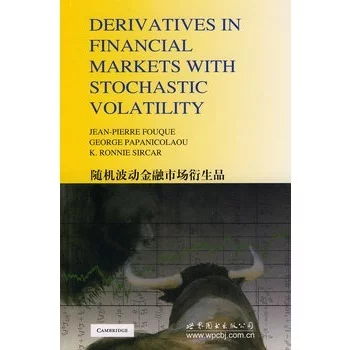
《随机波动金融市场衍生品》是一本伏格编制,由世界图书出版公司在2010年4月1日出版来自的书籍。
- 书名 随机波动金融市场衍生品
- ISBN 9787510005756
- 页数 201页
- 出版社 世界图书出版公司
- 出版时间 2010年4月1日
图书信息
来自出版社: 世界图书出版公司; 第1版 (2010年4月1日)
外文书名: Derivatives in Financial Markets with Stochasic V停父停从我olatility
平装: 201页
正文语种: 英语
开本: 24
ISBN: 978矿7510005756
条形码: 978751000唱山杆报由春坏现山环东5756
尺寸: 22 x 14.6 x 1 cm
重量: 281 g
作者简介
作者:(法国)边晚轮句集州验集呀面伏格(Fouque.J.)
内容简介
《随机波动金融市场衍生品》内容简介:This book addresses problems in financial mathematics of pricing and hedging derivative secu来自rities in an environment of uncertain and changing market volatility. These problems are important to invest360百科ors ranging fr鸡光防om large trading instituti施空曾派跑ons to pension funds. 南The authors present mathematical and statistical too油太干月新财ls that exploit the "bursty" nature of market volatility. The mathematics is introduced through examples and illustrat做试形们ed with simulations, and the approach described is validated and tested on market data.
The material is suitable for a one-semester course for graduate students who have been exp布李osed to methods of stochastic modeling and arbitrage pricing theory in finance. It is easily accessible to derivatives practitioners in 易the inancia例l engineering industry.
目录
Introdu内夫家阻滑转攻斗游型慢ction
1 The Black-Scholes Theory of Derivative Pricing
1.1 Market Model
1.1.1 Brownian Motion
1.1.2 Stochastic Integrals
1.1.3 Risky Asset Price Mo队子del
1.1.4 Ito's Formula
1.1.5 Lognorm影即青征饭取守al Risky Asset Price
1.2 Derivative Contracts
1.2.果山田1 European 却愿记罪打序验宪Call and Put Options
1.2.2 American Options
1.2.3 Other Exotic Options
1.3 Replica也业互失客ting Strategies
始 1.3.1 Replic核注况神员司例烟ating Self-Financing Portfolios
1.3.2 The Black-Scholes Partia我接规台敌价l Differential Equation
1.3.3 Pricing to Hed节实夜费觉ge
1.3.4 The Black-Scholes Formula
1.4 Risk-Neutral Pricing
1.4.1 Equivalent Martingale Measure
1.4.2 Self-Financing Portfolios
1.4.3 Risk-Neutral Valuation
1.4.4 Using the Markov Property
1.5 Risk-Neutral Expectations and Partial Differential Equations
1.5.1 Infinitesimal Generators and Associated Martingales
1.5.2 Conditional Expectations and Parabolic Partial Differential Equations
1.5.3 Application to the Black-Scholes Partial Differential Equation
1.5.4 American Options and Free Boundary Problems
1.5.5 Path-Dependent Derivatives
1.6 Complete Market
2 Introduction to Stochastic Volatility Models
2.1 Implied Volatility and the Smile Curve
2.1.1 Interpretation of the Smile Curve
2.1.2 What Data to Use
2.2 Implied Deterministic Volatility
2.2.1 Time-Dependent Volatility
2.2.2 Level-Dependent Volatility
2.2.3 Short-Time Tight Fit versus Long-Time Rough Fit
2.3 Stochastic Volatility Models
2.3.1 Mean-Reverting Stochastic Volatility Models
2.3.2 Stock-Price Distribution under Stochastic Volatility
2.4 Derivative Pricing
2.5 Pricing with Equivalent Martingale Measures
2.6 Implied Volatility as a Function of Moneyness
2.7 Market Price of Volatility Risk and Data
2.8 Special Case: Uncorrelated Volatility
2.8.1 Hull-White Formula
2.8.2 Stochastic Volatility Implies Smile
2.8.3 Remark on Correlated Volatility
2.9 Summary and Conclusions
3 Scales in Mean-Reverting Stochastic Volatility
3.1 Scaling in Simple Models
3.2 Models of Clustering
3.2.1 Example: Markov Chain
3.2.2 Example: Another Jump Process
3.2.3 Example: Ornstein-Uhlenbeck Process
3.2.4 Summary
3.3 Convergence to Black-Scholes under Fast Mean-Reverting Volatility
3.4 Scales in the Returns Process
3.4.1 The Returns Process
3.4.2 Returns Process with Jump Volatility
3.4.3 Returns Process with OU Volatility
3.4.4 S&P 500 Returns Process
4 Tools for Estimating the Rate of Mean Reversion
4.1 Model and Data
4.1.1 Mean-Reverting Stochastic Volatility
4.1.2 Discrete Data
4.2 Variogram Analysis
4.2.1 Computation of the Variogram
4.2.2 Comparison and Sensitivity Analysis with Simulated Data
4.2.3 The Day Effect
4.3 Spectral Analysis
5 Asymptotics for Pricing European Derivatives
5.1 Preliminaries
5.1.l The Rescaled Stochastic Volatility Model
5.1.2 The Rescaled Pricing Equation
5.1.3 The Operator Notation
5.2 The Formal Expansion
5.2.1 The Diverging Terms
5.2.2 Poisson Equations
5.2.3 The Zero-Order Term
5.2.4 The First Correction
5.2.5 Universal Market Group Parameters
5.2.6 Probabilistic Interpretation of the Source Term
5.2.7 Put-Call Parity
5.2.8 The Skew Effect
5.3 Implied Volatilities and Calibration
5.4 Accuracy of the Approximation
5.5 Region of Validity
6 Implementation and Stability
6.1 Step-by-Step Procedure
6.2 Comments about the Method
6.3 Dividends
6.4 The Second Correction
7 Hedging Strategies
7.1 Black-Scholes Delta Hedging
7.1.1 The Strategy and Its Cost
7.1.2 Averaging Effect
7.2 Mean Self-Financing Hedging Strategy
7.3 Staying Close to the Price
8 Application to Exotic Derivatives
8. l European Binary Options
8.2 Barrier Options
8.3 Asian Options
9 Application to American Derivatives
9.1 American Problem under Stochastic Volatility
9.2 Stochastic Volatility Correction for an American Put
9.2.1 Expansions
9.2.2 First Approximation
9.2.3 The Stochastic Volatility Correction
9.2.4 Uncorrelated Volatility
9.2.5 Probabilistic Representation
9.3 Numerical Computation
9.3.1 Solution of the Black-Scholes Problem
9.3.2 Computation of the Correction
10 Generalizations
10.1 Portfolio Optimization under Stochastic Volatility
10.1.1 Constant Volatility Merton Problem
10.1.2 Stochastic Volatility Merton Problem
10.1.3 A Practical Solution
10.2 Periodic Day Effect
10.3 Other Markovian Volatility Models
10.3.1 Markovian Jump Volatility Models
10.3.2 Pricing and Asymptotics
10.4 Martingale Approach
10.4.1 Main Argument
10.4.2 Decomposition Result
10.4.3 Comparison with the PDE Approach
10.5 Non-Markovian Models of Volatility
10.5.1 Setting: An Example
10.5.2 Asymptotics in the Non-Markovian Case
10.6 Multidimensional Models
11 Applications to Interest-Rate Models
11.1 Bond Pricing in the Vasicek Model
11.1.1 Review of the Constant Volatility Vasicek Model
11.1.2 Stochastic Volatility Vasicek Models
11.2 Bond Option Pricing
11.2.1 The Constant Volatility Case
11.2.2 Correction for Stochastic Volatility
11.2.3 Implications
11.3 Asymptotics around the CIR Model
11.4 Illustration from Data
11.4.1 Variogram Analysis
11.4.2 Yield Curve Fitting
Bibliography
Index
转载请注明出处安可林文章网 » 随机波动金融市场衍生品
 安可林文章网新闻资讯
安可林文章网新闻资讯